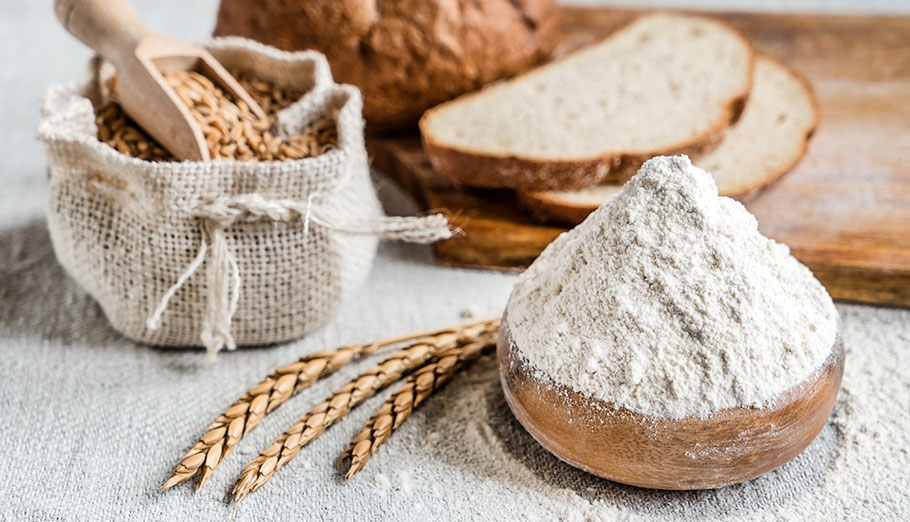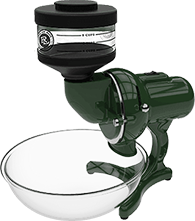Wheat

Overview (Has Gluten)
Wheat is a cereal grain believed to have originated from a random cross-pollination of three different species of grass around 10,000 BC. It is thought to have come originally from the Near East and, due to its ease of cultivation, was a major factor in mankind’s transition from nomadic hunter-gatherer to communal dweller. Archaeologists have found wheat in storage pits of 8,000-year-old settlements where ancient man lived. Today, more flour is produced from wheat than from any other grain.
Wheat flour is produced by grinding wheat kernels, known as wheat “berries.” There are two distinct wheat varieties—soft and hard. “Soft” refers to wheat with low gluten content, while “hard” refers to wheat with a high gluten content. The gluten in flours made with hard wheat give bread dough more elasticity, which results in bread that holds shape when baked. Soft flour, with its lower gluten content, yields bread with a fine and easily crumbled texture. These flours are commonly used for cakes and pastries, or mixed with hard flour to produce softer bread.
Wheat Flour Classifications
There are three ways to classify whole wheat: color (red and white), growing season (spring and winter) and hardness (hard and soft). Durum, the hardest of all wheat varieties, is considered a specialty variety. Along with its derivative Semolina, Durum is best known for its use in making pasta.
Red Wheat Flour vs. White Wheat Flour
Red wheat varieties are slightly higher in protein than white wheat, which make them not only valuable for daily use but also for storage in the event of an emergency. Baked goods made from red wheat flour have a hearty, almost “nutty” flavor quite distinct from those baked with standard white flour. The white wheat varieties have a more golden colored kernel. Breads made with white wheat flour will have a lighter color, more starch, and a milder flavor than breads made from red wheat.
Spring Wheat Flour vs. Winter Wheat Flour
Spring wheat is planted in the spring and harvested in the fall, while winter wheat is planted in the fall, sprouts just before winter freeze, becomes dormant until spring and is harvested in early summer. Winter wheat flours are generally higher in gluten than other wheat flours and are most often used in baking yeast bread, or for blending with spring wheat flour to make an all-purpose flour blend.
Hard Wheat Flour vs. Soft Wheat Flour
Hard wheat flour is milled from Hard White Spring wheat, Hard Red Spring Wheat (not grown in the US) or Hard Red Winter wheat (or any combination of the three). The hard wheats generally have a higher gluten (and protein) content. Soft wheat flour, on the other hand, is lower in gluten and high in starch. Typically, bread flour is made entirely from hard wheat, cake flour is made entirely from soft wheat, and most other baked goods use a combination of flours.
Nutrition
Since primitive man, wheat has been a staple food for humans. Marks on 13,000-year-old flint-bladed sickles found in Mesopotamia indicate man was cutting wild grasses with them. There is even archaeological evidence to show man was making flour as far back as 30,000 years ago—although not wheat flour. The cultivation of grasses, particularly wheat, was a major factor in mankind’s transition from nomadic hunter-gatherer to communal dweller.
The proteins, vitamins, enzymes and fiber in whole wheat flour make it far more nutritious than white flour. However, it cannot compare with the whole wheat flour you get by milling your own wheat berries. Large scale commercial flour producers, whose process involves separating the bran and the germ from the endosperm, simply blend back in some of the bran and germ and call this “whole wheat flour.” The oils in the germ are removed, however, and most of the vitamins and nutrients in the wheat are destroyed by heat generated in the milling process. On the other hand, freshly milled whole wheat flour not only retains all the nutrients in the wheat kernel, it also yields better tasting breads and baked goods.
Note: Weight of a cup (or partial cup) of flour varies depending upon whether it is lightly sprinkled into a measuring cup or compacted. Most recipe measurements are based on sifted flour as a way to arrive at more uniform measurement.
Whole Grain Wheat Flour with a Home Flour Mill
Hard wheats are tougher grains than the soft wheats, which makes them considerably more difficult to hand mill into the protein-rich flour needed for all sorts of baked goods. All wheat varieties can be milled with the Lee Household Flour Mill.
You’ll want to store your wheat berries in a secure, sealed container in a dry and cool place in your home. Without proper storage, wheat berries are susceptible to insects and can easily become moldy with exposure to moisture.
Gluten Content & Allergen Information
Wheat contains gluten, making it able to trigger inflammation if consumed by someone with a gluten sensitivity.
Nutrition Facts
| Serving Size | 1 Cup |
| Calories | 408 |
| Total Fat 3g | 4% |
| Cholesterol 0mg | 0% |
| Sodium 2mg | 1% |
| Carbohydrates 86g | 29% |
| Dietary Fiber 13g | 44% |
| Total Sugars 0g |
| Protein 16g |
| Vitamin D 0mcg | 0% |
| Calcium 41mg | 4% |
| Iron 4mg | 23% |
| Potassium 0mg | 0% |
* The % Daily Value (DV) tells you how much a nutrient in a serving of food contributes to a daily diet. 2,000 calories a day is used for general nutrition advice.
Diet Compatibility
Paleo Diet
The Paleo Diet seeks to emulate the hunter-gatherer diet of our stone-age ancestors. The emphasis is on wild plants and meats similar to what ancient man would have consumed. As such, dairy products, refined sugar and processed oils are off limits. While many Paleo Diet followers also avoid grains, there is ample archaeological evidence to show that grains were part of Paleolithic era man’s diet.
Compatibility with Wheat Flour:
Not Compatible

Mediterranean Diet
This diet seeks to emulate the diets of those living along the Mediterranean coast, with an emphasis on fresh fruits and vegetables, seafood/fish at least twice a week, limited servings of poultry, and only occasional sweets and red meat.
Compatibility with Wheat Flour:
Compatible

Gluten-Free Diet
As the name suggests, the gluten-free diet eliminates all foods with gluten. Although most of those on a gluten-free diet are on it out of necessity—either due to severe wheat allergies or Celiac disease—many have embraced a gluten-free diet as being healthier.
Compatibility with Wheat Flour:
Not Compatible

Macrobiotic Diet
Although there are many versions of macrobiotic diets, the common thread is that they emphasize natural, whole foods, grown locally and organically. Whole grains, vegetables, legumes, fruits, seeds and nuts, and occasional seafood are all integral to the diet. Red meats, dairy, poultry, eggs and processed foods are off the menu.
Compatibility with Wheat Flour:
Compatible

Acid Alkaline Diet
This diet aims to restore the slightly alkaline state of the body, which is believed to be ideal. By focusing on a diet high in vegetables, fruits, sprouted grains, lentils, almonds and soy products, the goal is to have a balance of 80% alkalizing foods and 20% acid forming foods.
Compatibility with Wheat Flour:
Compatible – Wheat Flour is condiered to be slightly acidic

Low-Carb Diet
As the name suggests, this diet focuses on reducing carbohydrates in the diet to lose weight. The theory is that by staying away from high-carb foods like pasta and bread and eating low carb, high fiber vegetables and fruits instead, your body will go into ketosis and you will lose weight. This diet is sometimes referred to as a ketogenic diet.
Compatibility with Wheat Flour:
Compatible in very limited quantities

Atkins Diet
The Atkins Diet is a historically popular low carb diet, instructing dieters not to worry about their calories but to monitor and minimize their intake of sugar and carbohydrates. According to Dr. Atkins, depriving the body of its primary energy sources causes the body to burn fat.
Compatibility with Wheat Flour:
Compatible in very limited quantities

“We love the mill! We use it every day for things from bread, to pastry and it is phenomenal. The biggest selling point for me was the fineness since that would mean we can really do some great pastry with it in addition to bread. It definitely has been great!"
BEN FROM NORTH CAROLINA

